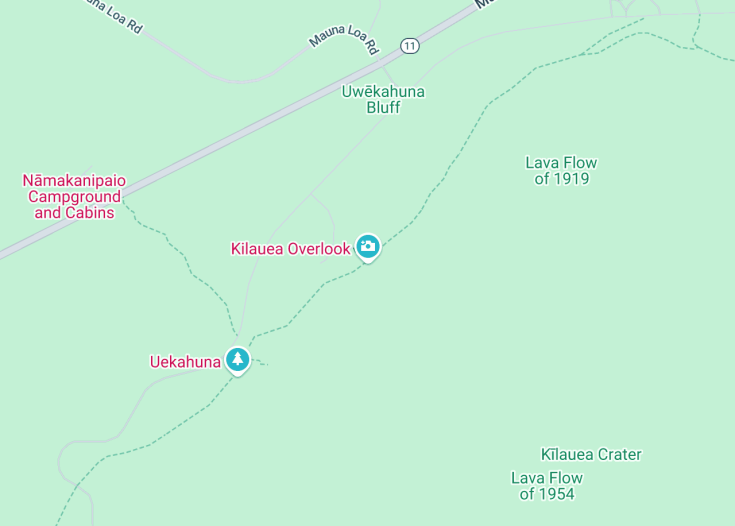Lying within the renowned Hawaii Volcanoes National Park, Kilauea Overlook offers visitors a unique vantage point to witness the majestic power of one of the world’s most active volcanoes, Kilauea. From this site, tourists can safely observe the dramatic volcanic landscapes and the ever-changing eruptions that draw scientists and adventurers alike from across the globe. This destination not only provides breathtaking views but also serves as an educational gateway to understanding the geological processes that shape our Earth.
For the best experience, visit Kilauea Overlook during early morning or late afternoon when the lighting accentuates the volcano’s features and the crowds are thinner.
Don’t forget to bring a pair of binoculars to enhance your viewing experience at Kilauea Overlook, allowing you to catch more details of the distant volcanic activity.
Kilauea Overlook: a majestic viewpoint
Kilauea Overlook offers visitors a spectacular vantage point to observe the grandeur of one of the most active volcanoes in the world, Kilauea, located within Hawaii Volcanoes National Park in Hawaii, USA. This location not only provides panoramic views of the Kilauea caldera and the Halema’uma’u crater but also allows the participants to feel the raw energy of the earth as it reshapes itself. Throughout the day, changes in natural light showcase the landscape in varying shades, offering striking photographic opportunities.
For those interested in geology, the site serves as a fantastic outdoor classroom where the processes of volcanic activity are visible and can be monitored in real time. Kilauea Overlook is accessible to all visitors, ensuring that everyone, regardless of their hiking ability, can experience the awe-inspiring power of Kilauea. Educational signs around the overlook provide valuable insights into the volcano’s history and the geological forces at play, making it not only a beautiful spot but also an enriching experience.
Whether you are a seasoned geologist, a photography enthusiast, or simply someone who loves unique natural landscapes, Kilauea Overlook is a must-visit destination.
Exploring the scenic and educational paths
At Kilauea Overlook, visitors can engage in several enriching activities designed to enhance their understanding and appreciation of volcanic landscapes. Guided tours offer in-depth explanations about the geological activity and are perfect for those looking to learn from experts. For a more immersive experience, self-guided walks along marked trails allow for personal encounters with the park’s unique geological features, with interpretative signage helping to identify key sights and explain volcanic processes. Photography enthusiasts will find the changing light conditions ideal for capturing stunning landscape photos, particularly during sunrise and sunset. Additionally, bird watchers can delight in spotting native bird species that thrive in this unique environment.
The ever-changing Halema’uma’u crater
The Halema’uma’u crater, visible from Kilauea Overlook, offers a compelling glimpse into the heart of Kilauea’s ceaseless activity. This crater is noteworthy for its dramatic transformations, which have been particularly evident since the significant eruption event in 2018. The crater floor, which collapsed and was subsequently enlarged, is now the site of a growing lava lake, visible from the overlook. This dynamic landscape continuously evolves, providing visitors with a firsthand look at the creation and alteration of new earth by volcanic forces. The visibility of these changes makes Halema’uma’u not only a fascinating geological feature but also a highlight for anyone visiting Kilauea Overlook.
Discover the Kilauea Overlook
Kilauea Overlook welcomes visitors of all ages, from kids to older adults, offering a spectacular view of Kilauea’s summit caldera. This scenic spot is perfect for couples seeking a romantic backdrop or families interested in geology and nature. Expect a serene atmosphere, breathtaking landscapes, and the chance to witness the elemental power of an active volcano.
When to Best Experience Kilauea Overlook
Visiting during early morning or late afternoon provides the most striking views, as the soft sunlight enhances the natural scenery. Additionally, fewer crowds at these times allow for a more intimate connection with nature.
Event Highlight
Volcano Awareness Month: January is ideal for educational trips, featuring talks and walks led by volcano experts.
Accessibility and Visitor Constraints at Kilauea Overlook
The overlook is designed to be accessible, allowing everyone to enjoy its majestic views, but certain areas might be less accessible due to natural terrain.
Accessibility
Limitations
- Drone flying is strictly prohibited.
- Pets are not allowed, except service animals.
- No overnight camping is available.
Notes to visitors
- Binoculars are recommended for a closer view of distant features.
- Weather can change rapidly; layered clothing is advised.
General Information
Details for your visit to Kilauea Overlook
Location
The overlook is near Volcano Village and adjacent to the main park road, making it easily accessible by car.
Address:
1 Crater Rim Drive, Hawaii Volcanoes National Park, HI 96718.
Opening hours
Open daily from sunrise to sunset.
Reaching the Kilauea Overlook
Kilauea Overlook is accessible from major nearby locations by various modes of transportation.
Car
Visiting by car is advisable as it allows direct access to the overlook with parking available nearby.
| Route | Distance | Travel time |
|---|---|---|
| From Hilo | 30 miles (48Km) | About 45 minutes |
| From Kona | 90 miles (145Km) | About 2 hours |
Bus
Although less frequent, buses serve the route from major areas:
| Route | Travel time |
|---|---|
| From Hilo | About 1.5 hours |
| From Kona | About 2.5 hours |
Nearby Attractions
Explore other attractions close to Kilauea Overlook:
- Hawaii Volcanoes National Park Visitor Center – 1 mile (1.6 km)
- Steam Vents – 2 miles (3.2 km)
- Thurston Lava Tube – 4 miles (6.4 km)
- Chain of Craters Road – 5 miles (8 km)
- Mauna Loa Observatory – 20 miles (32 km)
Common Questions
Remember the importance of updating visitor information regularly to accommodate any changes in accessibility or additional restrictions that may arise due to the natural dynamic environment of Hawaii Volcanoes National Park.
What can visitors see at Kilauea Overlook?
Is Kilauea Overlook safe for visitors?
What is the best time of day to visit Kilauea Overlook?
Are there guided tours available at Kilauea Overlook?
What facilities are available at Kilauea Overlook?
Can children visit Kilauea Overlook?
How long does a visit to Kilauea Overlook typically take?
What should visitors bring to Kilauea Overlook?
- Water and snacks, as there are no food services.
- Comfortable, sturdy footwear for walking.
- A jacket or sweater, as temperatures can be cooler at higher elevations.
- A camera or binoculars for taking photos or closer views of the craters.
- Sun protection, including sunscreen, sunglasses, and a hat.
Visitors should also bring a sense of adventure and an eagerness to learn about this unique volcanic landscape.
What wildlife might one see around Kilauea Overlook?
Are there any cultural significance associated with Kilauea Overlook?
Is there mobile reception at Kilauea Overlook?
Are there any restrictions on what can be brought to Kilauea Overlook?
- Drones, as they can disturb wildlife and violate visitor privacy.
- Alcoholic beverages are not permitted to maintain a family-friendly atmosphere.
- Pets, with the exception of service animals, to protect native wildlife and habitats.
It is important to check the latest guidelines from the National Park Service for any additional restrictions or updates.

Is the Kilauea Overlook in Volcano Worth a Visit?
Visiting the Kilauea Overlook offers a unique opportunity to witness one of the most active volcanoes in the world up close. The view from the overlook provides tourists with stunning vistas of the smoking caldera and the surrounding lush landscapes, making it a great spot for photography enthusiasts and nature lovers. However, it is important to consider the volatile nature of the area. The site can be dangerous due to sudden eruptions and air quality issues caused by volcanic smog, known as vog. Accessibility can also vary based on volcanic activity, which may restrict entry without prior notice. For the adventurous and those prepared with the right information, it is definitely a worthwhile visit. However, visitors should keep safety in mind and check local conditions before planning their trip.










